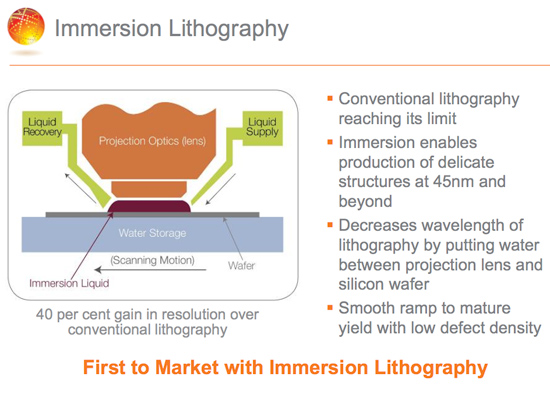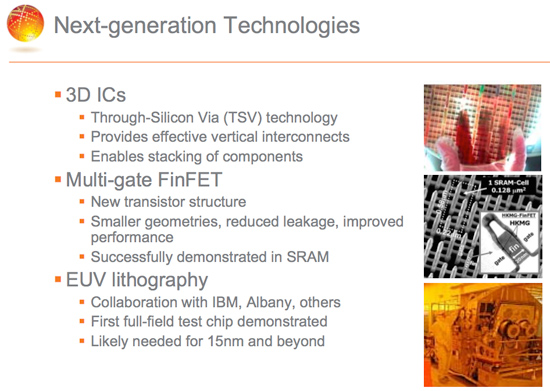Globalfoundries Starts on 22nm Fab & Announces First non-AMD Customer
by Anand Lal Shimpi on July 29, 2009 4:01 AM EST- Posted in
- CPUs
Maintaining Moore's Law
Every two years we need the ability to make chips smaller and cram more transistors into the same area. It makes microprocessors faster, more complex and cheaper depending on what you do to them. It also really helps with the whole ridiculous pace of innovation our industry likes to maintain.
If our ability to do that came to a halt, we'd be faced with our own little economic-depression in the microprocessor industry.
The threat that it will come to a halt is real, just as the confidence that we'll be able to innovate through for the next 10 - 15 years at least. It's all a matter of size. In order to cut transistor area in half every two years, you need to be able to physically design circuits that small - which requires some very expensive and precise equipment.
Hitting 45nm was difficult, but possible. AMD/Globalfoundries resorted to immersion lithography to make the transition. Basically it involves using liquid to improve the resolution of current 193nm lithography tools. By the time 32nm rolls around, Intel may have to do the same. Scaling beyond 32nm may reach the optical limitations of the current tools. Designing smaller, more densely packed chips may not be possible.

The replacement technology is something called extreme ultraviolet lithography. It's uses 13.5nm wavelength light (instead of 193nm) to be able to realize much finer patterns than current lithography tools.

Multi-gate transistors are also expected to be needed at or after 22nm to maintain the sort of progress we've been used to. Multi-gate transistors are also non-planar so you can physically fit more in the same area, helping density issues.
Remember die-stacking? That's coming too.










50 Comments
View All Comments
ClownPuncher - Wednesday, July 29, 2009 - link
98 F in Redmond currently, no AC in my house...I'm glad I went with some high CFM fans in my air cooled PC!BillyAZ1983 - Wednesday, July 29, 2009 - link
Pffft, here in lovely Bullhead City is a very chilly 120F. Pretty soon I might have to go get my jacket.JarredWalton - Thursday, July 30, 2009 - link
Ah, but I'd wager you have AC. Washingtonians don't believe in such things (at least not for homes), since it "never" gets that hot here. Ugh.... My house started at 86F this morning (8AM), got to 91F by noon, and reached a high of 96F by 6PM. Currently it's back down to 92F - yes, at 10PM. The fan by the door isn't helping much, considering it's only a few degrees cooler outside.strikeback03 - Wednesday, July 29, 2009 - link
...until I read that it was in Malta. Where there would certainly be rain if it was outdoors.Sottilde - Wednesday, July 29, 2009 - link
Hey Anand, thanks a ton for turning me on to CNSE. I was just starting my search for a graduate program. I'm determined not to be a CS code monkey the rest of my life!Pirks - Thursday, July 30, 2009 - link
I don't see how being a wafer pressing monkey is any betternunocordeiro - Wednesday, August 5, 2009 - link
Good luck fort you! CNSE does look like a good carrer investment. And don't mind Pirks. He is our own little private joke around these parts.blyndy - Wednesday, July 29, 2009 - link
The graph shows GF starting 32nm production in Q1 2010, which sounds great considering Intels 32nm product will start selling in Q4 2009.But it's easy to forget that it's many months between the start of volume production and the start of retail availability.
So, realistically, how long before a 32nm AMD CPU is available in retail? I would imagine the very end of Q3 2010 at the earliest, more likely mid-Q4, with a majority 32nm lineup a year after that. So, that is still roughly a year after Intel, but given previous transition timetables, not bad at all!
blyndy - Wednesday, July 29, 2009 - link
I like reading about the insides and technologies in fabs.Einy0 - Wednesday, July 29, 2009 - link
Yes, very interesting stuff... Nice to see this working out for GF / AMD... In fact to whole semi-conductor industry gets a new player with big money to build new high quality chips on cutting edge technology.